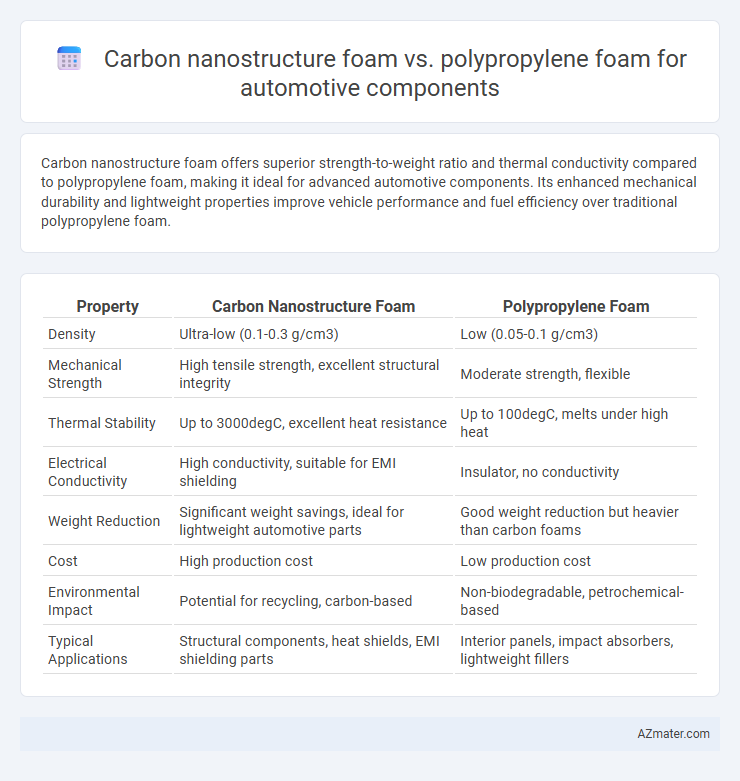Carbon nanostructure foam offers superior strength-to-weight ratio and thermal conductivity compared to polypropylene foam, making it ideal for advanced automotive components. Its enhanced mechanical durability and lightweight properties improve vehicle performance and fuel efficiency over traditional polypropylene foam.
Table of Comparison
| Property | Carbon Nanostructure Foam | Polypropylene Foam |
|---|---|---|
| Density | Ultra-low (0.1-0.3 g/cm3) | Low (0.05-0.1 g/cm3) |
| Mechanical Strength | High tensile strength, excellent structural integrity | Moderate strength, flexible |
| Thermal Stability | Up to 3000degC, excellent heat resistance | Up to 100degC, melts under high heat |
| Electrical Conductivity | High conductivity, suitable for EMI shielding | Insulator, no conductivity |
| Weight Reduction | Significant weight savings, ideal for lightweight automotive parts | Good weight reduction but heavier than carbon foams |
| Cost | High production cost | Low production cost |
| Environmental Impact | Potential for recycling, carbon-based | Non-biodegradable, petrochemical-based |
| Typical Applications | Structural components, heat shields, EMI shielding parts | Interior panels, impact absorbers, lightweight fillers |
Introduction to Automotive Foam Materials
Carbon nanostructure foam exhibits exceptional mechanical strength, thermal stability, and electrical conductivity, making it a cutting-edge material for automotive components requiring lightweight durability and advanced performance. Polypropylene foam, widely used in the industry, offers cost-effective impact absorption, good chemical resistance, and low density, suitable for interior and cushioning applications. Comparing these foams highlights a trade-off between the high-performance capabilities of carbon nanostructure foams and the economic efficiency of polypropylene foams in automotive manufacturing.
Overview of Carbon Nanostructure Foam
Carbon nanostructure foam offers superior mechanical strength, thermal stability, and lightweight properties compared to traditional polypropylene foam, making it highly suitable for advanced automotive components. Its high surface area and excellent electrical conductivity enhance noise reduction and electromagnetic interference shielding in vehicle interiors. These characteristics position carbon nanostructure foam as a next-generation material for durable, efficient, and high-performance automotive parts.
Properties of Polypropylene Foam
Polypropylene foam exhibits exceptional impact resistance, lightweight characteristics, and thermal insulation, making it ideal for automotive components requiring durability and energy absorption. Its low density contributes to overall vehicle weight reduction, enhancing fuel efficiency and lowering emissions. The material's chemical resistance and ease of fabrication further support its widespread use in automotive interiors and structural applications.
Comparative Mechanical Strength and Durability
Carbon nanostructure foam exhibits superior mechanical strength and enhanced durability compared to polypropylene foam, making it more suitable for high-performance automotive components subjected to cyclic stresses. Its high tensile strength, stiffness, and impact resistance contribute to better energy absorption and longer service life under harsh environmental conditions. Polypropylene foam, while lightweight and cost-effective, generally offers lower mechanical robustness and degrades faster under thermal and chemical exposure in automotive applications.
Weight Reduction and Fuel Efficiency
Carbon nanostructure foam offers superior weight reduction compared to polypropylene foam, significantly decreasing the overall mass of automotive components. This lightweight property directly enhances fuel efficiency by reducing energy consumption during vehicle operation. Furthermore, the advanced mechanical strength of carbon nanostructure foam ensures durability without compromising performance, making it a preferred material for automotive weight optimization and sustainability goals.
Thermal and Acoustic Insulation Performance
Carbon nanostructure foam exhibits superior thermal insulation due to its low thermal conductivity and high thermal stability, making it effective in managing heat within automotive components. Its porous, nanoscale architecture also enhances acoustic absorption, reducing noise levels more efficiently than traditional materials. In comparison, polypropylene foam offers moderate thermal insulation and sound dampening but lacks the advanced nano-engineered structure required for optimal performance in high-demand automotive environments.
Environmental Impact and Recyclability
Carbon nanostructure foam exhibits superior environmental benefits over polypropylene foam in automotive components due to its higher durability and enhanced recyclability, reducing waste and resource consumption. Polypropylene foam, while lightweight and cost-effective, poses challenges in recycling because of its mixed polymer composition and slower degradation, contributing to increased landfill accumulation. The advanced carbon nanostructure foam supports circular economy initiatives by enabling efficient recovery and reuse, significantly lowering the automotive industry's carbon footprint.
Cost Analysis and Manufacturing Considerations
Carbon nanostructure foam offers superior strength-to-weight ratio and thermal conductivity compared to polypropylene foam, but its higher raw material and production costs significantly impact overall budget feasibility in automotive components. Polypropylene foam benefits from well-established manufacturing processes such as injection molding and thermoforming, resulting in lower cycle times and minimal post-processing, which reduces labor expenses. Manufacturing considerations also include the scalability of polypropylene foam production, enabling cost-effective mass production, whereas carbon nanostructure foam requires advanced techniques like chemical vapor deposition, limiting its economic viability for large-scale automotive applications.
Safety and Regulatory Compliance
Carbon nanostructure foam offers superior impact absorption and energy dissipation compared to polypropylene foam, enhancing occupant safety in automotive components by reducing injury risks during collisions. Its advanced thermal stability and resistance to combustion contribute to meeting stringent automotive fire safety regulations such as FMVSS 302 and UNECE R118. While polypropylene foam is widely used for its lightweight and cost-effectiveness, carbon nanostructure foam aligns more closely with evolving regulatory demands for improved crashworthiness and material durability.
Future Trends in Automotive Foam Technologies
Carbon nanostructure foam exhibits superior mechanical strength, thermal conductivity, and lightweight properties compared to polypropylene foam, making it a promising material for next-generation automotive components. Emerging trends emphasize integrating carbon-based nanomaterials to enhance crashworthiness, energy absorption, and sustainability in vehicle design. Advanced manufacturing techniques such as additive manufacturing and foam hybridization are driving innovations, optimizing performance while reducing environmental impact in future automotive foam technologies.

Infographic: Carbon nanostructure foam vs Polypropylene foam for Automotive component
 azmater.com
azmater.com